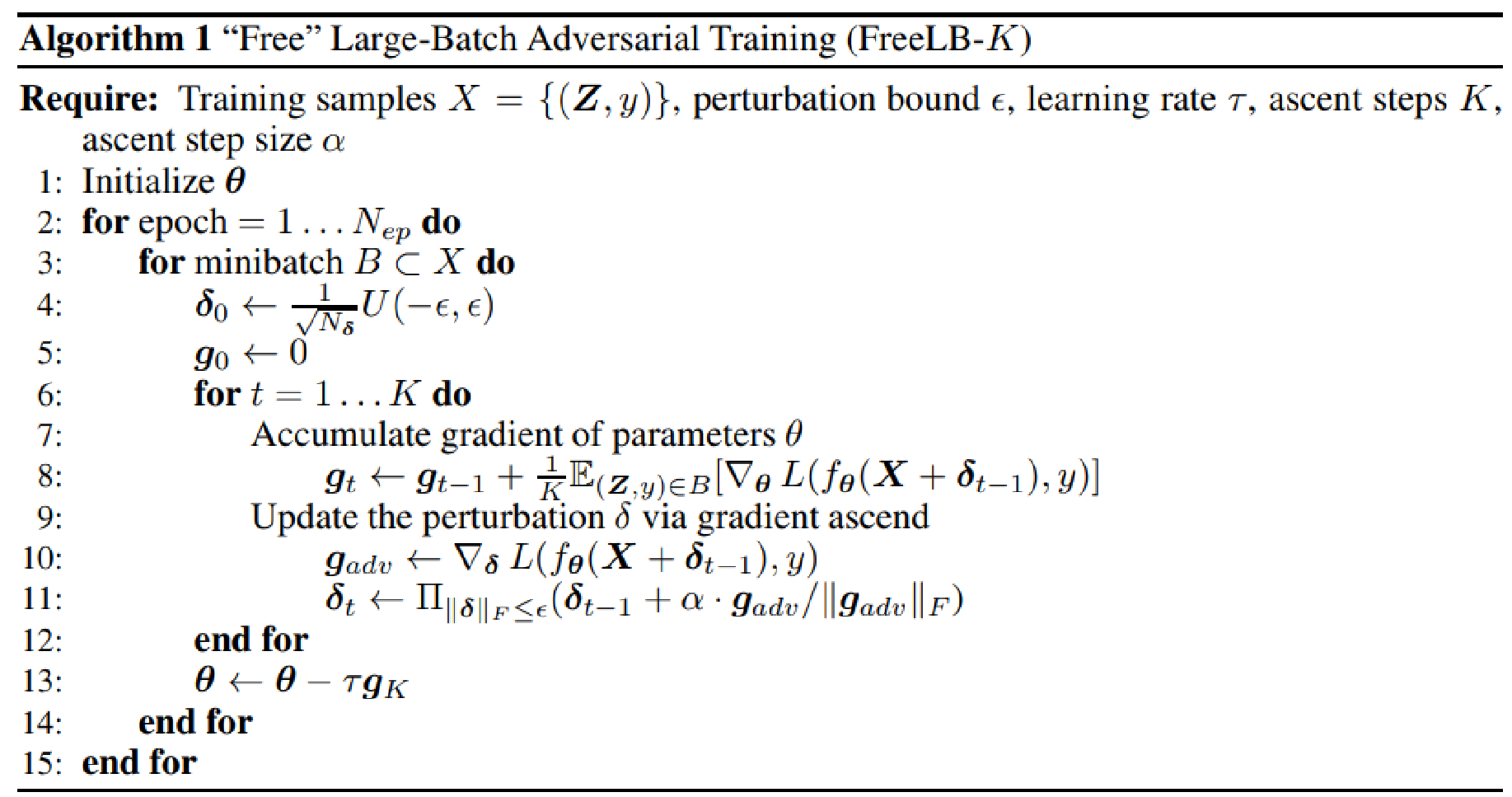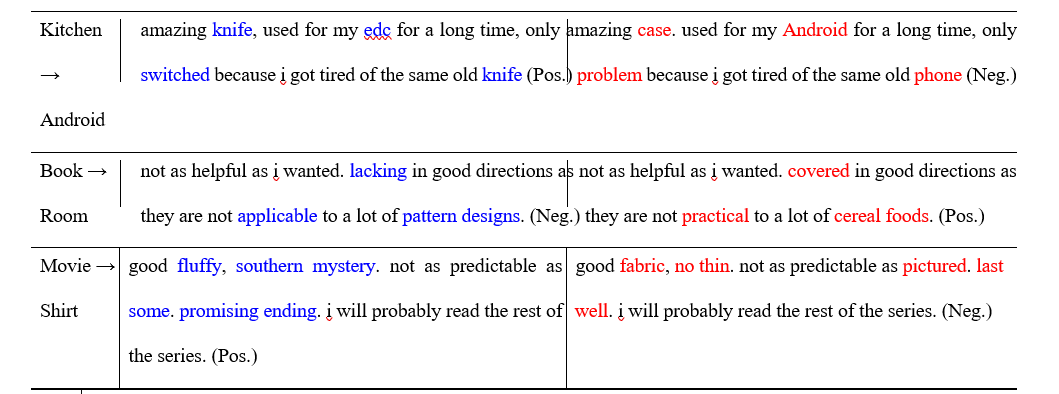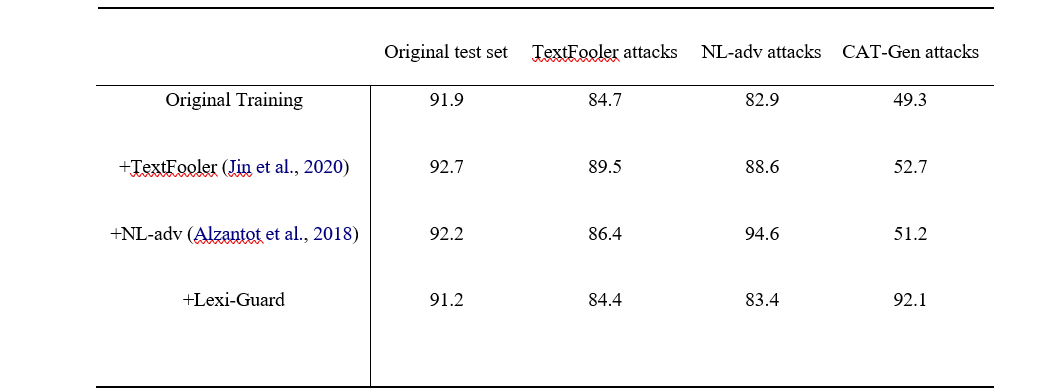1. Introduction
Zhou et al. state that prior research has demonstrated that NLP models face difficulties due to adversarial attacks and out-of-distribution data [24]. According to Jia and Liang, Jin et al., and Alzantot et al., various research studies addressing the adversarial attack challenge have proposed the generation of adversarial examples within the input text space or intermediary representation domains [2, 14, 16]. Existing research on the construction of adversarial examples within the input text space, however, frequently demonstrates fluency issues and tends to produce adversarial instances that do not adhere to semantic restrictions and grammaticality criteria. Table 1 illustrates these limitations by highlighting the deficiencies of the available research on adversarial instances.
In this work, we aim to address limitations of prior research works in this space. Our goal is in line with Wang et al.'s exploration of the pursuit of producing adversarial cases while including controllable features [22]. We suggest utilizing text generation techniques to provide adversarial examples that are more contextually relevant and diversified. We also focus on designing perturbations that can achieve two unique goals: effectively reducing the predictive performance of an NLP model (thus resulting in inaccurate predictions) and complying to a preset set of language constraints. These goals can be achieved by using a method that is based on previous research and calls for the development of controlled qualities in order to produce a collection of diverse, excellent adversarial examples that are semantically consistent with the original input text.
In terms of technical notation, our system refers to the input text as "x," the label for the main job (such as sentiment analysis in the context of text classification) as "y," the model's prediction for "x" as "f(x)," and the controllable attributes (such as gender, dataset domain), as "a." Our main goal is to create adversarial perturbations, marked by the letter "x," that can successfully trick the classifier into producing an inaccurate prediction, denoted by the letter "f(x)" "f(x)." We designate the change from '(x, y)' to '(x', y)' in order to assure the accuracy of our adversarial training and data annotation.
We use the Adversarial Text Generation model developed by Wang et al. to achieve this goal [22]. However, we use a completely different model architecture, apply it to a variety of datasets, and adjust the hyperparameters. The adversarial example generation model consists of an encoder and a decoder that were both trained on a large text corpus to ensure semantic coherence and adherence to linguistic restrictions. Implementing previous research's concepts and tightening the cosine similarity thresholds between sentence encodings of original and perturbed sentences and embeddings of replacement words are required to enforce semantic fidelity. By putting alterations via a grammar checker for validation, grammatical fidelity is also maintained. In addition, we incorporate grammatical and semantic limitations at each stage of the search process, emulating Moriss et al.
Real-world NLP datasets are used for our experimental validation, which demonstrates the effectiveness, adaptability, and generalizability of our suggested methodology. Our results show that the generated adversarial attacks have increased diversity, as measured by the BLEU-4 score, and have improved resistance to model retraining attempts and changes in model topologies.
2. Related work
The efficacy of employing adversarial examples as a means to enhance the robustness of Natural Language Processing (NLP) models against adversarial attacks has recently been revealed in numerous research endeavors [1, 6, 8, 12, 14, 18]. It is worth mentioning that Alzantot et al. and Jin et al. have devised methodologies for generating adversarial texts by substituting words with their synonyms, as determined by their proximity in the word embedding space [2, 16]. This approach leads to the creation of written content that perplexes models and induces erroneous classifications. Zhao et al. proposed a novel approach to creating adversarial instances in the context of continuous data representation [24]. Their research focused on exploring the semantic domain and resulted in the development of a Generative Adversarial Network (GAN) that is capable of producing coherent and comprehensible adversarial examples. Jia et al. conducted a study in a relevant context, whereby they explored word replacement combinations that aim to reduce the largest worst-case loss [15]. This investigation employed the widely utilized interval bound propagation technique. Zhu et al. have adopted a unique approach by focusing on the incorporation of adversarial perturbations into word embeddings, rather than generating textual outputs directly [25]. The objective of this approach is to mitigate adversarial risk associated with input instances.
Our research builds upon the work of Wang et al. in the field of controlled adversarial text generation [22]. Specifically, we want to enhance the performance of their model, CAT.Gen, by generating adversarial texts that are both more engaging and coherent. The scope of their suggested model's implementation is constrained to a singular dataset, specifically the Amazon Review dataset, and a singular machine learning architecture, namely the Recurrent Neural Network (RNN). However, the model demonstrates its capability to generate more authentic and contextually relevant adversarial instances in real-world scenarios. The objective of our study is to expand upon their established methodology by applying it to an alternative dataset (IMDB) and employing a transformer-based neural network. This choice is motivated by the remarkable performance exhibited by transformer models, such as BERT, in several language tasks, including sentiment categorization. The inclusion of a grammatical validation process, which ensures that the produced adversarial examples conform to proper grammar and semantic coherence, is a notable enhancement compared to the CAT-Gen model. Furthermore, a notable computational burden arises when training extensive batches of adversarial samples, which is a limitation of the Wang et al. study [22]. This problem becomes particularly evident when applying their approach to a substantial dataset such as Yelp Polarity. In light of the considerable processing time we encountered, despite utilizing robust computer resources, our investigation focused on identifying a more efficient approach for generating hostile instances. To accomplish this objective, the inner ascent stages of Projected Gradient Descent (PGD) are employed. PGD is a widely used optimization technique in the field of machine learning due to its ability to efficiently compute parameter gradients without incurring significant additional computational costs when computing gradients of inputs.
The investigation we are conducting is closely connected to the topic of controllable text generation. In contrast, Iyyer et al. developed a system known as the Syntactically Controlled Paraphrase Network (SCPN) to generate adversarial instances [12]. For example, Hu et al. conducted a study exploring the utilization of variational auto-encoders in combination with holistic attribute discriminators [11]. The approach utilized in this study is founded upon an encoder-decoder model, which effectively generates adversarial training data, hence enhancing the model's resilience against adversarial attacks. Furthermore, Zhu et al. propose FreeLB, a unique technique for adversarial training that aims to enhance the level of invariance within the embedding space [25]. In this approach, the inclusion of adversarial perturbations in word embeddings is employed, and the subsequent minimization of adversarial risk is carried out across many regions including the input samples. The utilization of this approach on Transformer-based models for tasks pertaining to the comprehension of natural language and reasoning based on common sense demonstrates its effectiveness, as evidenced by the attainment of improved benchmark test outcomes for models such as BERT-base and RoBERTa-large. The authors' treatment of the temporal features of NLP models is insufficient, as they neglect to include potential temporal variations and shifts in data patterns. This issue holds significant importance, particularly in practical scenarios where the forthcoming data may exhibit variations from the characteristics and patterns observed in the training data.
3. Method
Our proposed strategy for producing adversarial cases is schematically depicted in Figure 1. Our approach is optimized for creating attacks with a narrow focus, in this case sentiment classification. This is accomplished by manipulating the property in question inside a given input sentence (in this case, product reviews). Encoder, decoder, and attribute classifier make up the model architecture; these components are also present in prior work on controlled text generation [5, 11, 21]. The system incorporates parts to make it easier to alter attributes and create assaults inside a given job model.

Figure 1. provides an overview of our adversarial examples generation technique.
The process of backpropagation is employed. The utilization of cross entropy loss (shown by a black dashed line) is employed to guarantee that the adversarial examples created by our system comply with grammar requirements and maintain semantic coherence. Please guarantee that the sentence generated possesses a comparable semantic meaning to the original input sentence. The manipulation of attributes (shown by the green dashed line) is used to induce attribute loss in the generated sentence, which is unrelated to the task label. The prediction of sentiment labels on generated text exhibits variability while altering the attribute denoted as "a" representing different categories.
|
Method |
Examples |
|
Textfooler(Jin et al., 2020) |
A person is relaxing on his day off → A person is relaxing on his nowadays off The two men are friends → The three men are dudes |
|
NL-adv (Alzantot et.al., 2018) |
A man is talking to his wife over his phone → A guy is chitchat to his girl over his phone A skier gets some air near a mountain… → A skier gets some airplane near a mountain… |
|
Natural-GAN (Zhao et al., 2018) |
a girl is playing at a looking man → a white preforming is lying on a beach two friends waiting for a family together → the two workers are married |
Examples of adversarial text generation models that have been tested on the SNLI dataset are provided in Table 1 above [4]. Word-swapping techniques (Textfooler and NL-adv) can generate adversarial text with diverse or restricted semantics, while GAN techniques (Natural-GAN) are more likely to produce sentences that break the rules of the adversarial task.
3.1 The generation of adversarial examples at scale with high efficiency.
It is firmly believed that the optimization process is fundamental to any machine learning algorithm. Consequently, significant effort was dedicated to improving our algorithm in order to efficiently generate substantial batches of adversarial examples (AEs) and ultimately develop the most effective adversarial attacks. In order to achieve this objective, The inner ascent stages of Projected Gradient Descent (PGD), which is a well-established and highly efficient optimization technique, were utilized in our study. in the field of machine learning. By utilizing PGD, we were able to extract the gradients of the parameters with minimal computational cost while calculating the gradients of the inputs.

Figure 2. Optimization algorithm details to generate adversarial examples at scale
4. Analysis and discussion
To accomplish our goal, we employ the gong 2018 adversarial dataset sourced from IMDB. This dataset consists of binarized ratings that incorporate both positive and negative feelings. The dataset was partitioned into a training set and a test set, consisting of 25,000 reviews each. However, only 2,000 reviews from the training set were utilized for the purposes of development and testing. To allow parameter change and final evaluation, a development set and a test set are maintained, each including 10,000 occurrences. Subsequently, our classifier is trained and optimized through the application of the gradient descent optimization algorithm, utilizing both the training and development sets. The evaluation of the model's performance includes measuring its accuracy on the original instances from the test sets, as well as on adversarial examples that are generated using targeted attack methods particularly tailored for the test set. The BERT model, which is considered state-of-the-art (SOTA), will be used to classify both the attributes (category) and the task labels (sentiment) in our text. The projector employs a singular layer of Multilayer Perceptron (MLP). Throughout the progression of our research, we have seen that the training process can exhibit instability as a result of the utilization of the gumbel softmax technique for generating soft embeddings. Additionally, we have noticed that there are instances where the output sentence tends to replicate the input sentence. In accordance with the suggestions put forth by Hu et al., we meticulously calibrated the temperature parameter for the gumbel softmax [11]. Additionally, it was shown that utilizing a network with limited capacity, such as a one-layer MLP with a hidden size of 256, as the projector for the controlled attribute, along with a higher dropout ratio on sentence embeddings, such as 0.5, contributes to the stabilization of the training process. Both of these discoveries are located in the preceding section. Table 4 presents an analysis of the transferability of our instances in relation to established adversarial text generation systems, namely Jin et al. and Alzantot et al. [2,16]. The aforementioned experiments were conducted by Jin et al. and Alzantot et al.
|
Model Architecture |
TextFooler (Jin e 2020) |
NL-adv (Alzant al., 2018) |
LexiGuard |
|
|
Bert-retraining |
84.7 |
82.9 |
48.2 |
|
|
WordCNN |
85.6 |
80.5 |
50.6 |
Table 4 presents the accuracy results obtained from conducting various attacks on a re-trained model and a distinct architecture. It is important to acknowledge that the accuracy of the original model is recorded as zero due to the inclusion of a hold-out 1K set that exclusively consists of successful attacks in the evaluation process.
The results derived through qualitative analysis. Table 2 presents qualitative examples of our Lexi-Guard model. The observations indicate that the model exhibits the ability to generate adversarial texts that possess grammatical accuracy, diversity, and semantic preservation. Moreover, the model effectively substitutes many words from the initial input in order to conform to the new category attribute. The attainment of this accomplishment presents a considerable level of difficulty when relying exclusively on the substitution of synonyms or doing nearest-neighbor searches within the word embedding space. This has been exemplified in prior studies conducted by Jin et al. and Alzantot et al. [2,16]. To illustrate, our system effectively modifies the product description from "good fluffy, southern mystery" to "good fabric, not thin," thereby aligning with the attribute shift from "movie" to "shirt."
Attribute Original sentence with attribute a Generated sentence with perturbed attribute x’
(x → x’ )

Table 2: Successful adversarial examples generated by our Lexi-Guard model on the Movie Review Dataset.
b. Adversarial Training
The results of adversarial training, a widely used technique to enhance models by incorporating adversarial cases, are displayed in Table 3 [7]. In our study. The created adversarial samples were partitioned into two separate categories. One subset was employed to increase the size of the training data, while the other subset was used as a hold-out set for the purpose of testing. The BERT sentiment classifier model, which was previously used in Table 4, is retrained using supplemented training data. Subsequently, the model is evaluated on the hold-out set. Table 3 demonstrates the augmentation of training data with adversarial instances created by each approach, as indicated by the rows. The evaluation of model performance on the hold-out set is also conducted separately for each method, as indicated by the columns. It is evident that the incorporation of Lexi-Guard examples yields superior results in enhancing performance on Lexi-Guard assaults compared to the utilization of baselines. The baselines employ more limited substitutions, whereas the integration of Lexi-Guard examples not only enhances performance but also sustains a high level of accuracy in baseline attacks.

Table. In row 3, the initial training set is enhanced with the inclusion of hostile attacks. The evaluation and presentation of the accuracy of the hold-out 1K adversarial attacks, created by our approach as well as two alternative baselines, are conducted and showcased in columns.
5 Conclusion and future work
This study introduces Lexi-Guard, a paradigm that effectively generates adversarial cases while maintaining simplicity. Lexi-Guard has the capability to produce a wide range of hostile writings that are both semantically accurate and grammatically sound. Our assertion is that our model produces adversarial examples that are more pertinent to real-world issues due to the increased resilience of our attacks against model re-training and across various model architectures. The efficacy and minimal resource consumption of our technology render it attractive when compared to alternative adversarial text generators. The advantage of our approach lies specifically inside this domain. Our optimization approach additionally enables the model to acquire knowledge on the task-irrelevant attributes that are most susceptible to attack, hence enhancing its adaptability. Regarding future advancements, it would be a reasonable progression to extend the application of this methodology to diverse linguistic tasks, including but not limited to natural language inference and question answering. One such course of action that could be pursued is as follows. Additionally, it would be intriguing to assess the model's practical performance.



